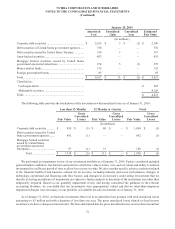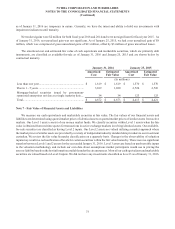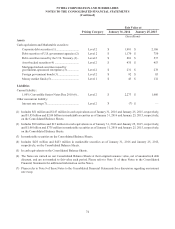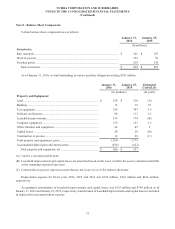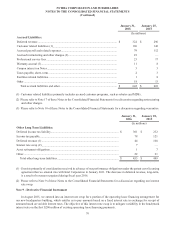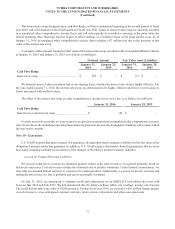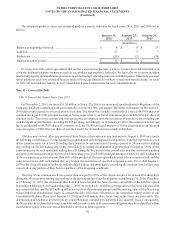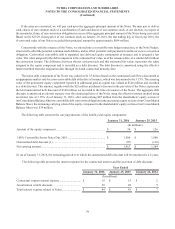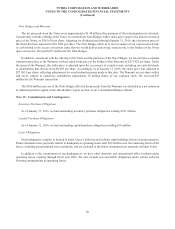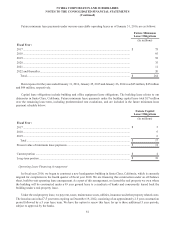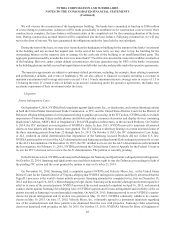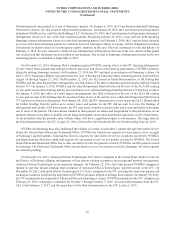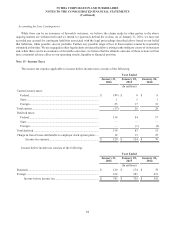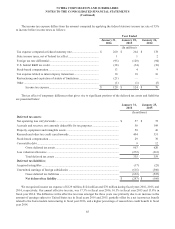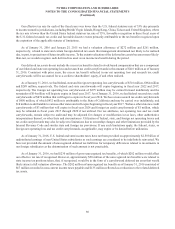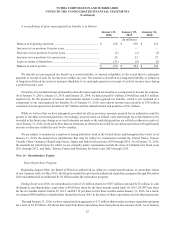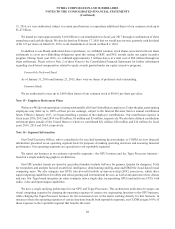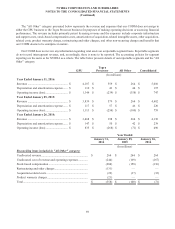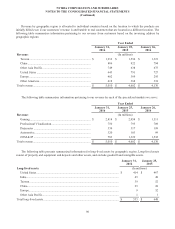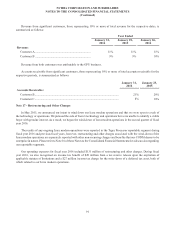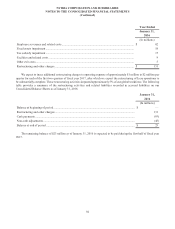NVIDIA 2016 Annual Report Download - page 228
Download and view the complete annual report
Please find page 228 of the 2016 NVIDIA annual report below. You can navigate through the pages in the report by either clicking on the pages listed below, or by using the keyword search tool below to find specific information within the annual report.NVIDIA CORPORATION AND SUBSIDIARIES
NOTES TO THE CONSOLIDATED FINANCIAL STATEMENTS
(Continued)
82
We will oversee the construction of the headquarters building. The banks have committed to fund up to $380 million
of costs relating to construction. Advances will be made periodically to reimburse us for construction costs we incur. Once
construction is complete, the lease balance will remain static at the completed cost for the remaining duration of the lease
term. During construction, accrued interest will be capitalized into the lease balance. Following construction, we will pay
rent in the form of interest. We have guaranteed the obligations under the lease held by our subsidiary.
During the term of the lease, we may elect to purchase the headquarters building for the amount of the banks’ investment
in the building and any accrued but unpaid rent. At the end of the lease term, we may elect to buy the building for the
outstanding balance on the maturity date or arrange for the cash sale of the building to an unaffiliated third party. The
aggregate guarantee made by us under the lease is no more than 87.5% of the costs incurred in connection with the construction
of the building. However, under certain default circumstances, the lease guarantee may be 100% of the banks’ investment
in the building plus any and all accrued but unpaid interest and all other rent due and payable under the operative agreements.
The operative agreements are subject to customary default provisions, including, for example, those relating to payment
and performance defaults, and events of bankruptcy. We are also subject to financial covenants including a covenant to
maintain a maximum total leverage ratio not to exceed 3.0 to 1.0 and a minimum interest coverage ratio in excess of 3.5 to
1.0 during the term. If certain events of default occur and are continuing under the operative agreements, the banks may
accelerate repayment of their investment under the lease.
Litigation
Patent Infringement Cases
On September 4, 2014, NVIDIA filed complaints against Qualcomm, Inc., or Qualcomm, and various Samsung entities
in both the United States International Trade Commission, or ITC, and the United States District Court for the District of
Delaware alleging infringement of seven patents relating to graphics processing. In the ITC action, NVIDIA seeks to exclude
importation of Samsung Galaxy mobile phones and tablets and other consumer electronics and display devices containing
Qualcomm’s Adreno, ARM’s Mali or Imagination’s PowerVR graphics architectures, or the Accused Products. On October
6, 2014, the ITC instituted an investigation of NVIDIA’s claim. In June 2015, NVIDIA moved to terminate all asserted
claims on four patents and these motions were granted. The ITC held an evidentiary hearing on certain asserted claims of
the three remaining patents from June 22 through June 26, 2015. On October 9, 2015, the ITC Administrative Law Judge,
or ALJ, rendered an initial determination that importation of the Samsung Accused Products did not violate U.S. law.
NVIDIA petitioned for review of the ALJ’s determination and Samsung and Qualcomm filed contingent petitions for review
of the ALJ’s determination. On December 14, 2015, the ITC decided not to review the ALJ’s determination and terminated
the Investigation. On February 11, 2016, NVIDIA petitioned the United States Court of Appeals for the Federal Circuit to
review the ITC’s decision not to review the ALJ’s determination. The petition is currently pending.
In the Delaware action, NVIDIA seeks unspecified damages for Samsung and Qualcomm’s alleged patent infringement.
On October 22, 2014, Samsung and Qualcomm exercised their statutory right to stay the Delaware proceedings in light of
the pending ITC action and the court granted the motion to stay on October 23, 2014.
On November 10, 2014, Samsung filed a complaint against NVIDIA and Velocity Micro, Inc., in the United States
District Court for the Eastern District of Virginia, alleging that NVIDIA infringed six patents and falsely advertised that the
Tegra K1 processor is the world’s fastest mobile processor. Samsung amended its complaint twice, first on December 19,
2014, and then on April 10, 2015, without changing its legal claims. Samsung seeks monetary damages and certain injunctive
relief as to some of the asserted patents. NVIDIA answered the second amended complaint on April 16, 2015, and asserted
counter-claims against Samsung for infringing four of NVIDIA’s patents and for non-infringement and invalidity of the six
patents asserted in Samsung’s second amended complaint. On April 24, 2015, Samsung moved to sever NVIDIA’s counter-
claims for patent infringement and its motion was granted on May 19, 2015. NVIDIA voluntarily withdrew its counter-
claims on May 19, 2015. On June 17, 2015, Velocity Micro, Inc. voluntarily agreed to a permanent injunction regarding
two of the asserted patents and those patents were dismissed from the case with prejudice. Samsung’s false advertising
claim was dismissed with prejudice on July 30, 2015. On October 15, 2015, NVIDIA’s Motion for Entry of Judgment of


